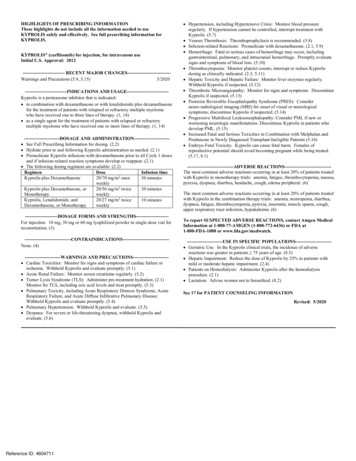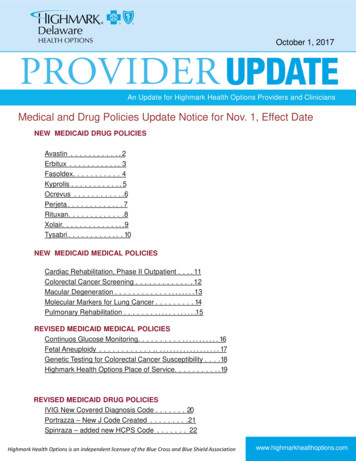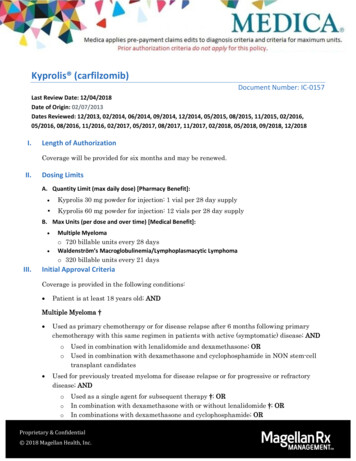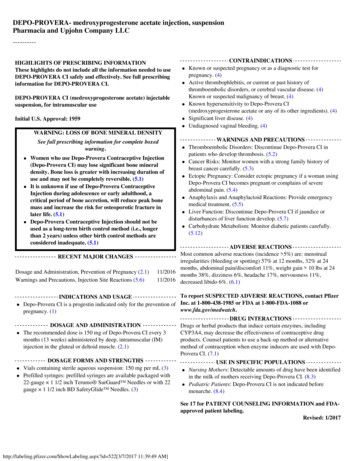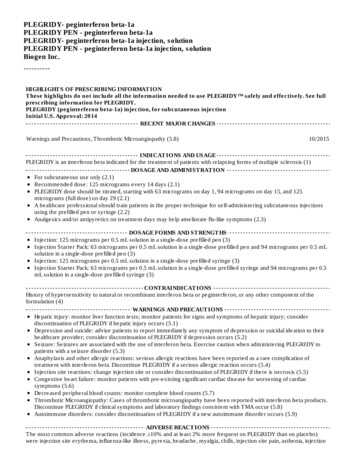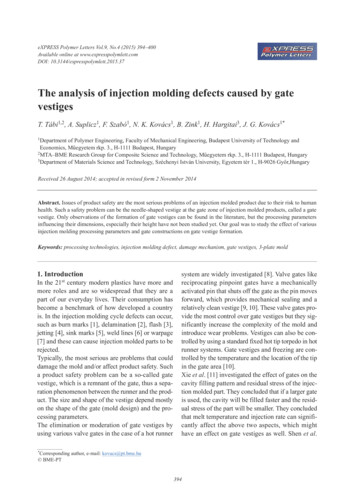
Transcription
HIGHLIGHTS OF PRESCRIBING INFORMATIONThese highlights do not include all the information needed to useKYPROLIS safely and effectively. See full prescribing information forKYPROLIS.KYPROLIS (carfilzomib) for injection, for intravenous useInitial U.S. Approval: 2012--------------------------- RECENT MAJOR CHANGES---------------------------Dosage and Administration (2.1, 2.2, 2.3, 2.6)02/2019Warnings and Precautions (5.1, 5.2, 5.4, 5.6, 5.7, 5.11, 5.16)09/2018---------------------------INDICATIONS AND USAGE--------------------------Kyprolis is a proteasome inhibitor that is indicated: in combination with dexamethasone or with lenalidomide plus dexamethasonefor the treatment of patients with relapsed or refractory multiple myelomawho have received one to three lines of therapy. (1, 14) as a single agent for the treatment of patients with relapsed or refractorymultiple myeloma who have received one or more lines of therapy. (1, 14)-----------------------DOSAGE AND ADMINISTRATION---------------------- See Full Prescribing Information for dosing. (2.2) Hydrate prior to and following Kyprolis administration as needed. (2.1) Premedicate Kyprolis infusions with dexamethasone prior to all Cycle 1 dosesand if infusion reaction symptoms develop or reappear. (2.1) The following dosing regimens are available: (2.2)RegimenDoseInfusion timeKyprolis plus Dexamethasone20/70 mg/m2 once30 minutesweeklyKyprolis plus Dexamethasone, or20/56 mg/m2 twice30 minutesMonotherapyweeklyKyprolis, Lenalidomide, and20/27 mg/m2 twice10 minutesDexamethasone, or Monotherapyweekly---------------------DOSAGE FORMS AND STRENGTHS--------------------For injection: 10 mg, 30 mg or 60 mg, lyophilized powder in single-dose vial forreconstitution. -----------------------------None. (4)-----------------------WARNINGS AND PRECAUTIONS---------------------- Cardiac Toxicities: Monitor for signs and symptoms of cardiac failure orischemia. Withhold Kyprolis and evaluate promptly. (5.1) Acute Renal Failure: Monitor serum creatinine regularly. (5.2) Tumor Lysis Syndrome (TLS): Administer pre-treatment hydration. (2.1)Monitor for TLS, including uric acid levels and treat promptly. (5.3) Pulmonary Toxicity, including Acute Respiratory Distress Syndrome, AcuteRespiratory Failure, and Acute Diffuse Infiltrative Pulmonary Disease:Withhold Kyprolis and evaluate promptly. (5.4) Pulmonary Hypertension: Withhold Kyprolis and evaluate. (5.5)Reference ID: 4397304 Dyspnea: For severe or life-threatening dyspnea, withhold Kyprolis andevaluate. (5.6) Hypertension, including Hypertensive Crisis: Monitor blood pressureregularly. If hypertension cannot be controlled, interrupt treatment withKyprolis. (5.7) Venous Thrombosis: Thromboprophylaxis is recommended. (5.8) Infusion Reactions: Premedicate with dexamethasone. (2.1, 5.9) Hemorrhage: Fatal or serious cases of hemorrhage may occur, includinggastrointestinal, pulmonary, and intracranial hemorrhage. Promptly evaluatesigns and symptoms of blood loss. (5.10) Thrombocytopenia: Monitor platelet counts; interrupt or reduce Kyprolisdosing as clinically indicated. (2.3, 5.11) Hepatic Toxicity and Hepatic Failure: Monitor liver enzymes regularly.Withhold Kyprolis if suspected. (5.12) Thrombotic Microangiopathy: Monitor for signs and symptoms. DiscontinueKyprolis if suspected. (5.13) Posterior Reversible Encephalopathy Syndrome (PRES): Considerneuro-radiological imaging (MRI) for onset of visual or neurologicalsymptoms; discontinue Kyprolis if suspected. (5.14) Increased Fatal and Serious Toxicities in Combination with Melphalan andPrednisone in Newly Diagnosed Transplant-Ineligible Patients (5.15) Embryo-Fetal Toxicity: Kyprolis can cause fetal harm. Females ofreproductive potential should avoid becoming pregnant while being treated.(5.16, 8.1)------------------------------ADVERSE REACTIONS-----------------------------The most common adverse reactions occurring in at least 20% of patients treatedwith Kyprolis in monotherapy trials: anemia, fatigue, thrombocytopenia, nausea,pyrexia, dyspnea, diarrhea, headache, cough, edema peripheral. (6)The most common adverse reactions occurring in at least 20% of patients treatedwith Kyprolis in the combination therapy trials: anemia, neutropenia, diarrhea,dyspnea, fatigue, thrombocytopenia, pyrexia, insomnia, muscle spasm, cough,upper respiratory tract infection, hypokalemia. (6)To report SUSPECTED ADVERSE REACTIONS, contact Amgen MedicalInformation at 1-800-77-AMGEN (1-800-772-6436) or FDA at1-800-FDA-1088 or www.fda.gov/medwatch.-----------------------USE IN SPECIFIC POPULATIONS---------------------- Geriatric Use: In the Kyprolis clinical trials, the incidence of adverse eventswas greater in patients 75 years of age. (8.5) Hepatic Impairment: Reduce the dose of Kyprolis by 25% in patients withmild or moderate hepatic impairment. (2.4) Patients on Hemodialysis: Administer Kyprolis after the hemodialysisprocedure. (2.1) Lactation: Advise women not to breastfeed. (8.2)See 17 for PATIENT COUNSELING INFORMATIONRevised: 02/20191
FULL PRESCRIBING INFORMATION: CONTENTS*1 INDICATIONS AND USAGE1.1Relapsed or Refractory Multiple Myeloma2 DOSAGE AND ADMINISTRATION2.1Administration Precautions2.2Recommended Dosing2.3Dose Modifications Based on Toxicities2.4Dose Modifications for Use in Hepatic Impairment2.5Dosing in Patients with End Stage Renal Disease2.6Reconstitution and Preparation for Intravenous Administration3 DOSAGE FORMS AND STRENGTHS4 CONTRAINDICATIONS5 WARNINGS AND PRECAUTIONS5.1Cardiac Toxicities5.2Acute Renal Failure5.3Tumor Lysis Syndrome5.4Pulmonary Toxicity5.5Pulmonary Hypertension5.6Dyspnea5.7Hypertension5.8Venous Thrombosis5.9Infusion Reactions5.10 Hemorrhage5.11 Thrombocytopenia5.12 Hepatic Toxicity and Hepatic Failure5.13 Thrombotic Microangiopathy5.14 Posterior Reversible Encephalopathy Syndrome5.15 Increased Fatal and Serious Toxicities in Combination withMelphalan and Prednisone in Newly Diagnosed Transplant-IneligiblePatients5.16 Embryo-Fetal Toxicity6 ADVERSE REACTIONS6.1Clinical Trials Experience6.2Postmarketing ExperienceReference ID: 4397304810111213141617USE IN SPECIFIC POPULATIONS8.1 Pregnancy8.2 Lactation8.3 Females and Males of Reproductive Potential8.4 Pediatric Use8.5 Geriatric Use8.6 Hepatic ImpairmentOVERDOSAGEDESCRIPTIONCLINICAL PHARMACOLOGY12.1 Mechanism of Action12.2 Pharmacodynamics12.3 PharmacokineticsNONCLINICAL TOXICOLOGY13.1 Carcinogenesis, Mutagenesis, Impairment of Fertility13.2 Animal Toxicology and/or PharmacologyCLINICAL STUDIES14.1 In Combination with Lenalidomide and Dexamethasone for theTreatment of Patients with Relapsed or Refractory Multiple Myeloma14.2 In Combination with Dexamethasone for the Treatment of Patientswith Relapsed or Refractory Multiple Myeloma14.3 Monotherapy for the Treatment of Patients with Relapsed orRefractory Multiple MyelomaHOW SUPPLIED/STORAGE AND HANDLING16.1 How Supplied16.2 Storage and HandlingPATIENT COUNSELING INFORMATION*Sections or subsections omitted from the Full Prescribing Information arenot listed.2
FULL PRESCRIBING INFORMATION1INDICATIONS AND USAGE1.1Relapsed or Refractory Multiple Myeloma Kyprolis is indicated in combination with dexamethasone or with lenalidomide plusdexamethasone for the treatment of patients with relapsed or refractory multiple myelomawho have received one to three lines of therapy. Kyprolis is indicated as a single agent for the treatment of patients with relapsed orrefractory multiple myeloma who have received one or more lines of therapy.2DOSAGE AND ADMINISTRATION2.1Administration Precautions Hydration - Adequate hydration is required prior to dosing in Cycle 1, especially inpatients at high-risk of tumor lysis syndrome (TLS) or renal toxicity. The recommendedhydration includes both oral fluids (30 mL per kg at least 48 hours before Cycle 1, Day 1)and intravenous fluids (250 mL to 500 mL of appropriate intravenous fluid prior to eachdose in Cycle 1). If needed, give an additional 250 mL to 500 mL of intravenous fluidsfollowing Kyprolis administration. Continue oral and/or intravenous hydration, asneeded, in subsequent cycles. Monitor patients for evidence of volume overload andadjust hydration to individual patient needs, especially in patients with or at risk forcardiac failure [see Warnings and Precautions (5.1, 5.3)]. Electrolyte Monitoring - Monitor serum potassium levels regularly during treatmentwith Kyprolis. Premedications - Premedicate with the recommended dose of dexamethasone formonotherapy or the recommended dexamethasone dose if on combination therapy [seeDosage and Administration (2.2)]. Administer dexamethasone orally or intravenously atleast 30 minutes but no more than 4 hours prior to all doses of Kyprolis during Cycle 1 toreduce the incidence and severity of infusion reactions [see Warnings andPrecautions (5.9)]. Reinstate dexamethasone premedication if these symptoms occurduring subsequent cycles.3Reference ID: 4397304
Administration - Kyprolis can be administered in a 50 mL or 100 mL intravenous bag of5% Dextrose Injection, USP. Infuse over 10 or 30 minutes depending on the Kyprolisdose regimen [see Dosage and Administration (2.2)]. Administer as an intravenousinfusion. Flush the intravenous administration line with normal saline or 5% DextroseInjection, USP immediately before and after Kyprolis administration. Do not mixKyprolis with or administer as an infusion with other medicinal products. Dose Calculation - Calculate the Kyprolis dose [see Dosage and Administration (2.2)]using the patient’s actual body surface area (BSA) at baseline. In patients with a BSAgreater than 2.2 m2, calculate the dose based upon a BSA of 2.2 m2. Thromboprophylaxis - Thromboprophylaxis is recommended for patients being treatedwith the combination of Kyprolis with dexamethasone or with lenalidomide plusdexamethasone. The thromboprophylaxis regimen should be based on an assessment ofthe patient’s underlying risks [see Warnings and Precautions (5.8)]. Infection Prophylaxis - Consider antiviral prophylaxis for patients being treated withKyprolis to decrease the risk of herpes zoster reactivation. 2.2Patients on Hemodialysis - Administer Kyprolis after the hemodialysis procedure.Recommended DosingKyprolis in Combination with DexamethasoneFor the combination regimen with dexamethasone alone, administer Kyprolis intravenouslyonce weekly or twice weekly as a 30-minute infusion as described in Table 1 & 2 below.Once weekly 20/70 mg/m2 regimen by 30-minute infusionKyprolis is administered intravenously as a 30-minute infusion once weekly for three weeksfollowed by a 13-day rest period as shown in Table 1. Each 28-day period is considered onetreatment cycle. Administer Kyprolis at a starting dose of 20 mg/m2 in Cycle 1 on Day 1. Iftolerated, escalate the dose to 70 mg/m2 on Day 8 of Cycle 1. Dexamethasone 40 mg is takenby mouth or intravenously on Days 1, 8, and 15 of all cycles and on Day 22 of Cycles 1 to 9.Administer dexamethasone 30 minutes to 4 hours before Kyprolis.4Reference ID: 4397304
Table 1: Kyprolis Once Weekly (30-Minute Infusion) in Combination withDexamethasoneCycle 1Week 1Week 2Week 3Week 70-----Dexamethasone (mg)40--40--40--40--Cycles 2 to 9Week 1Week 2Week 3Week 70-----Dexamethasone (mg)40--40--40--40-Cycles 10 and laterWeek 1Week 2Week 3Week 70-----Dexamethasone (mg)40--40--40-----Treatment may be continued until disease progression or unacceptable toxicity occurs [seeDosage and Administration (2.3)]. Refer to the dexamethasone Prescribing Information forother information on that product.Twice weekly 20/56 mg/m2 regimen by 30-minute infusionKyprolis is administered intravenously as a 30-minute infusion on two consecutive days,each week for three weeks followed by a 12-day rest period as shown in Table 2. Each28-day period is considered one treatment cycle. Administer Kyprolis at a starting dose of20 mg/m2 in Cycle 1 on Days 1 and 2. If tolerated, escalate the dose to 56 mg/m2 on Day 85Reference ID: 4397304
of Cycle 1. Dexamethasone 20 mg is taken by mouth or intravenously on Days 1, 2, 8, 9, 15,16, 22, and 23 of each 28-day cycle. Administer dexamethasone 30 minutes to 4 hoursbefore Kyprolis.Table 2: Kyprolis Twice Weekly (30-Minute Infusion) in Combination withDexamethasoneCycle 1Week 1Week 2Week 3Week k 1Cycles 2 and laterWeek 2Week 3DaysDaysDay Day10–Day 5656-5656-5656Dexamethasone(mg)2020-2020-2020Week 4Day22Day23Days24-28-----2020-Treatment may be continued until disease progression or unacceptable toxicity occurs [seeDosage and Administration (2.3)]. Refer to the dexamethasone Prescribing Information forother information on that product.Kyprolis in Combination with Lenalidomide and DexamethasoneFor the combination regimen with lenalidomide and dexamethasone, administer Kyprolisintravenously as a 10-minute infusion on two consecutive days, each week for three weeksfollowed by a 12-day rest period as shown in Table 3. Each 28-day period is considered onetreatment cycle. The recommended starting dose of Kyprolis is 20 mg/m2 in Cycle 1 onDays 1 and 2. If tolerated, escalate the dose to 27 mg/m2 on Day 8 of Cycle 1. FromCycle 13, omit the Day 8 and 9 doses of Kyprolis. Discontinue Kyprolis after Cycle 18.Lenalidomide 25 mg is taken orally on Days 1–21 and dexamethasone 40 mg by mouth orintravenously on Days 1, 8, 15, and 22 of the 28-day cycles.6Reference ID: 4397304
Table 3: Kyprolis Twice Weekly (10-Minute Infusion) in Combination withLenalidomide and DexamethasoneCycle 1Week 1Week 2Week ---Dexamethasone (mg)40--40--40--40---Lenalidomide25 mg daily on Days 1-21Cycles 2 to 12Week 2Week 1Week 3Week ---Dexamethasone (mg)40--40--40--40---Lenalidomide25 mg daily on Days 1-21Cycles 13 and lateraWeek 2Week 1Week 3Week -Dexamethasone (mg)40--40--40--40---LenalidomideaWeek 325 mg daily on Days 1-21Kyprolis is administered through Cycle 18; lenalidomide and dexamethasone continue thereafter.Continue treatment until disease progression or unacceptable toxicity occurs [see Dosageand Administration (2.3)]. Refer to the lenalidomide and dexamethasone PrescribingInformation for other concomitant medications, such as the use of anticoagulant and antacidprophylaxis, that may be required with those agents.7Reference ID: 4397304
Kyprolis MonotherapyFor monotherapy, administer Kyprolis intravenously twice weekly as a 10-minute or30-minute infusion depending on the regimen as described below.20/27 mg/m2 twice weekly regimen by 10-minute infusionFor monotherapy using the 20/27 mg/m2 regimen, administer Kyprolis intravenously as a10-minute infusion [see Clinical Studies (14.3)]. In Cycles 1 through 12, administerKyprolis on two consecutive days, each week for three weeks followed by a 12-day restperiod as shown in Table 4. Each 28-day period is considered one treatment cycle. FromCycle 13, omit the Day 8 and 9 doses of Kyprolis (see Table 4). Premedicate withdexamethasone 4 mg orally or intravenously 30 minutes to 4 hours before each Kyprolis dosein Cycle 1, then as needed to help prevent infusion reactions [see Dosage andAdministration (2.1)]. The recommended starting dose of Kyprolis is 20 mg/m2 in Cycle 1on Days 1 and 2. If tolerated, escalate the dose to 27 mg/m2 on Day 8 of Cycle 1. Treatmentmay continue until disease progression or unacceptable toxicity occurs.Table 4: Kyprolis Monotherapy 20/27 mg/m2 Twice Weekly (10-Minute Infusion)Cycle 1Day1Kyprolis (mg/m2)a20Week 1Day Days23–720-Week 1Day Day Days123–7Kyprolis (mg/m2)27Day1Kyprolis (mg/m2)a2727-Week 1Day Days23–727-Day827Week 2Day Days910–1427-Day1527Cycles 2 to 12Week 2Day Day DaysDay8910–14152727-27Cycles 13 and laterWeek 2Day Day DaysDay8910–1415---27Week 3DayDays1617–2127-Week 3DayDays1617–2127-Week 3DayDays1617–2127-Week 4Days22–28Week 4Days22–28Week 4Days22–28-Dexamethasone premedication is required for each Kyprolis dose in Cycle 1.8Reference ID: 4397304
20/56 mg/m2 twice weekly regimen by 30-minute infusionFor monotherapy using the 20/56 mg/m2 regimen, administer Kyprolis intravenously as a30-minute infusion [see Clinical Studies (14.3)]. In Cycles 1 through 12, administerKyprolis on two consecutive days, each week for three weeks followed by a 12-day restperiod as shown in Table 5. Each 28-day period is considered one treatment cycle. FromCycle 13, omit the Day 8 and 9 doses of Kyprolis (see Table 5). Premedicate withdexamethasone 8 mg orally or intravenously 30 minutes to 4 hours before each Kyprolis dosein Cycle 1, then as needed to help prevent infusion reactions [see Dosage andAdministration (2.1)]. The recommended starting dose of Kyprolis is 20 mg/m2 in Cycle 1on Days 1 and 2. If tolerated, escalate the dose to 56 mg/m2 on Day 8 of Cycle 1. Treatmentmay continue until disease progression or unacceptable toxicity occurs.Table 5: Kyprolis Monotherapy 20/56 mg/m2 Twice Weekly (30-Minute Infusion)Cycle 1Week 1Day Day Days123–7Kyprolis (mg/m2)a2020-Week 1Day Day Days123–7Kyprolis (mg/m2)5656-Week 1Day Day Days123–7Kyprolis (mg/m2)a5656-Day856Day856Day8-Week 2DayDays910–1456-Day1556Cycles 2 to 12Week 2DayDaysDay910–141556-56Cycles 13 and laterWeek 2DayDaysDay910–1415--56Week 3DayDays1617–2156-Week 3DayDays1617–2156-Week 3DayDays1617–2156-Week 4Days22–28Week 4Days22–28Week 4Days22–28-Dexamethasone premedication is required for each Kyprolis dose in Cycle 1.2.3Dose Modifications Based on ToxicitiesModify dosing based on toxicity. Recommended actions and dose modifications forKyprolis are presented in Table 6. Dose level reductions are presented in Table 7. See thelenalidomide and dexamethasone Prescribing Information respectively for dosingrecommendations.9Reference ID: 4397304
Table 6: Dose Modifications for Toxicitya during Kyprolis TreatmentHematologic ToxicityRecommended Action ANC less than 0.5 10 /L9 Febrile neutropeniaANC less than 0.5 109/L and anoral temperature more than 38.5 Cor two consecutive readings ofmore than 38.0 C for 2 hours Platelets less than 10 109/L orevidence of bleeding withthrombocytopenia[see Warnings and Precautions (5)] Withhold dose If recovered to greater than or equal to 0.5 109/L,continue at the same dose level For subsequent drops to less than 0.5 109/L, follow the samerecommendations as above and consider 1 dose level reductionwhen restarting Kyprolisa Withhold dose If ANC returns to baseline grade and fever resolves,resume at the same dose level Withhold dose If recovered to greater than or equal to 10 109/L and/orbleeding is controlled, continue at the same dose level For subsequent drops to less than 10 109/L, follow the samerecommendations as above and consider 1 dose level reductionwhen restarting KyprolisaRenal ToxicityRecommended Action Serum creatinine greater than orequal to 2 baseline, or Creatinine clearance lessthan 15 mL/min, or creatinineclearance decreases to less than orequal to 50% of baseline, or needfor hemodialysis[see Warnings and Precautions (5)] Withhold dose and continue monitoring renal function (serumcreatinine or creatinine clearance) If attributable to Kyprolis, resume when renal function hasrecovered to within 25% of baseline; start at 1 dose levelreductiona If not attributable to Kyprolis, dosing may be resumed atthe discretion of the physician For patients on hemodialysis receiving Kyprolis, the dose is tobe administered after the hemodialysis procedureOther Non-hematologic ToxicityRecommended Action All other severe or life-threateningnon-hematological toxicitiesb Withhold until resolved or returned to baseline Consider restarting the next scheduled treatment at 1 doselevel reductionaANC absolute neutrophil counta See Table 7 for dose level reductions.b CTCAE Grade 3 and 4.Table 7: Dose Level Reductions for Kyprolis ToxicityRegimenDoseFirst DoseReductionSecond DoseReductionThird DoseReductionKyprolis and Dexamethasone(once weekly)70 mg/m256 mg/m245 mg/m236 mg/m2aKyprolis andDexamethasone, orMonotherapy (twice weekly)56 mg/m245 mg/m236 mg/m227 mg/m2a10Reference ID: 4397304
RegimenDoseFirst DoseReductionSecond DoseReductionThird DoseReductionKyprolis, Lenalidomide, andDexamethasone, orMonotherapy (twice weekly)27 mg/m220 mg/m215 mg/m2a—Note: Infusion times remain unchanged during dose reduction(s).a If toxicity persists, discontinue Kyprolis treatment.2.4Dose Modifications for Use in Hepatic ImpairmentFor patients with mild or moderate hepatic impairment, reduce the dose of Kyprolis by 25%.Dosing recommendation cannot be made in patients with severe hepatic impairment [see Usein Specific Populations (8.6), Clinical Pharmacology (12.3)].2.5Dosing in Patients with End Stage Renal DiseaseFor patients with end stage renal disease who are on hemodialysis, administer Kyprolis afterthe hemodialysis procedure.2.6Reconstitution and Preparation for Intravenous AdministrationKyprolis vials contain no antimicrobial preservatives and are intended for single use only.Unopened vials of Kyprolis are stable until the date indicated on the package when stored inthe original package at 2 C to 8 C (36 F to 46 F). The reconstituted solution containscarfilzomib at a concentration of 2 mg/mL.Read the complete preparation instructions prior to reconstitution. Parenteral drug productsshould be inspected visually for particulate matter and discoloration prior to administration,whenever solution and container permit.Reconstitution/Preparation Steps:1.Remove vial from refrigerator just prior to use.2.Calculate the dose (mg/m2) and number of vials of Kyprolis required using thepatient’s BSA at baseline. Patients with a BSA greater than 2.2 m2 should receive adose based upon a BSA of 2.2 m2. Dose adjustments do not need to be made forweight changes of less than or equal to 20%.3.Aseptically reconstitute each Kyprolis vial only with Sterile Water for Injection, USPusing the volumes described in Table 8. Use a 21-gauge or larger needle (0.8 mm orsmaller external diameter needle) to reconstitute each vial by slowly injecting SterileWater for Injection, USP through the stopper and directing the Sterile Water forInjection, USP onto the INSIDE WALL OF THE VIAL to minimize foaming. Thereis no data to support the use of closed system transfer devices with Kyprolis.11Reference ID: 4397304
Table 8: Reconstitution Volumes4.5.6.7.8.StrengthAmount of Sterile Water for Injection, USP requiredfor reconstitution10 mg vial5 mL30 mg vial15 mL60 mg vial29 mLGently swirl and/or invert the vial slowly for about 1 minute, or until completedissolution. DO NOT SHAKE to avoid foam generation. If foaming occurs, allowthe solution to settle in the vial until foaming subsides (approximately 5 minutes) andthe solution is clear.Visually inspect for particulate matter and discoloration prior to administration. Thereconstituted product should be a clear, colorless solution and should not beadministered if any discoloration or particulate matter is observed.Discard any unused portion left in the vial. DO NOT pool unused portions from thevials. DO NOT administer more than one dose from a vial.Kyprolis can be administered directly by intravenous infusion or optionally,administered in a 50 mL to 100 mL intravenous bag containing 5% DextroseInjection, USP. Do not administer as an intravenous push or bolus.When administering in an intravenous bag, use a 21-gauge or larger gauge needle(0.8 mm or smaller external diameter needle) to withdraw the calculated dose [seeDosage and Administration (2)] from the vial and dilute into 50 mL or 100 mLintravenous bag containing only 5% Dextrose Injection, USP (based on thecalculated total dose and infusion time).The stabilities of reconstituted Kyprolis under various temperature and container conditionsare shown in Table 9.12Reference ID: 4397304
Table 9: Stability of Reconstituted KyprolisStorage Conditions of Reconstituted KyprolisabVialStabilitya per ContainerIntravenous BagSyringe(D5Wb)Refrigerated 2 C to 8 C (36 F to 46 F)24 hours24 hours24 hoursRoom Temperature 15 C to 30 C (59 F to 86 F)4 hours4 hours4 hoursTotal time from reconstitution to administration should not exceed 24 hours.5% Dextrose Injection, USP.3DOSAGE FORMS AND STRENGTHSKyprolis is supplied as follows: For injection: 10 mg lyophilized cake or powder in single-dose vial for reconstitution For injection: 30 mg lyophilized cake or powder in single-dose vial for reconstitution For injection: 60 mg lyophilized cake or powder in single-dose vial for reconstitution4CONTRAINDICATIONSNone.5WARNINGS AND PRECAUTIONS5.1Cardiac ToxicitiesNew onset or worsening of pre-existing cardiac failure (e.g., congestive heart failure,pulmonary edema, decreased ejection fraction), restrictive cardiomyopathy, myocardialischemia, and myocardial infarction including fatalities have occurred followingadministration of Kyprolis. Some events occurred in patients with normal baselineventricular function. In clinical studies with Kyprolis, these events occurred throughout thecourse of Kyprolis therapy. Death due to cardiac arrest has occurred within one day ofKyprolis administration. In randomized, open-label, multicenter trials for combinationtherapies, the incidence of cardiac failure events was 8% [see Adverse Reactions (6.1)].Monitor patients for clinical signs or symptoms of cardiac failure or cardiac ischemia.Evaluate promptly if cardiac toxicity is suspected. Withhold Kyprolis for Grade 3 or 4cardiac adverse events until recovery and consider whether to restart Kyprolis at 1 dose levelreduction based on a benefit/risk assessment [see Dosage and Administration (2.3)].13Reference ID: 4397304
While adequate hydration is required prior to each dose in Cycle 1, all patients should also bemonitored for evidence of volume overload, especially patients at risk for cardiac failure.Adjust total fluid intake as clinically appropriate in patients with baseline cardiac failure orwho are at risk for cardiac failure [see Dosage and Administration (2.1)].In patients 75 years of age, the risk of cardiac failure is increased compared topatients 75 years of age. Patients with New York Heart Association Class III and IV heartfailure, recent myocardial infarction, conduction abnormalities, angina, or arrhythmiasuncontrolled by medications were not eligible for the clinical trials. These patients may be atgreater risk for cardiac complications and should have a comprehensive medical assessment(including blood pressure control and fluid management) prior to starting treatment withKyprolis and remain under close follow-up [see Use in Specific Populations (8.5)].5.2Acute Renal FailureCases of acute renal failure have occurred in patients receiving Kyprolis. Some of theseevents have been fatal. Renal insufficiency adverse events (including renal failure) haveoccurred in approximately 11% of patients treated with Kyprolis. Acute renal failure wasreported more frequently in patients with advanced relapsed and refractory multiple myelomawho received Kyprolis monotherapy. The risk of fatal renal failure was greater in patientswith a baseline reduced estimated creatinine clearance (calculated using Cockcroft-Gaultequation). Monitor renal function with regular measurement of the serum creatinine and/orestimated creatinine clearance. Reduce or withhold dose as appropriate [see Dosage andAdministration (2.3)].5.3Tumor Lysis SyndromeCases of tumor lysis syndrome (TLS), including fatal outcomes, have been reported inpatients who received Kyprolis. Patients with multiple myeloma and a high tumor burdenshould be considered to be at greater risk for TLS. Ensure that patients are well hydratedbefore administration of Kyprolis in Cycle 1, and in subsequent cycles as needed [seeDosage and Administration (2.1)]. Consider uric acid-lowering drugs in patients at risk forTLS. Monitor for evidence of TLS during treatment and manage promptly, includinginterruption of Kyprolis until TLS is resolved [see Dosage and Administration (2.1)].14Reference ID: 4397304
5.4Pulmonary ToxicityAcute Respiratory Distress Syndrome (ARDS), acute respiratory failure, and acute diffuseinfiltrative pulmonary disease such as pneumonitis and interstitial lung disease have occurredin approximately 1% of patients receiving Kyprolis. Some events have been fatal. In theevent of drug-induced pulmonary toxicity, discontinue Kyprolis [see Dosage andAdministration (2.3)].5.5Pulmonary HypertensionPulmonary arterial hypertension was reported in approximately 1% of patients treated withKyprolis and was Grade 3 or greater in less than 1% of patients. Evaluate with cardiacimaging and/or other tests as indicated. Withhold Kyprolis for pulmonary hypertension untilresolved or returned to baseline and consider whether to restart Kyprolis based on abenefit/risk assessment [see Dosage and Administration (2.3)].5.6DyspneaDyspnea was reported in 28% of patients treated with Kyprolis and was Grade 3 or greater in4% of patients. Evaluate dyspnea to exclude cardiopulmonary conditions including cardiacfailure and pulmonary syndromes. Stop Kyprolis for Grade 3 or 4 dyspnea until resolved orreturned to baseline. Consider whether to restart Kyprolis based on a benefit/risk assessment[see Dosage and Administration (2.3), Warnings and Pr
Kyprolis is administered intravenously as a 30-minute infusion once weekly for three weeks followed by a 13-day rest period as shown in Table 1. Each 28-day period is considered one treatment cycle. Administer Kyprolis at a starting dose of 20 mg/m2 in Cycle 1 on Day 1. If

